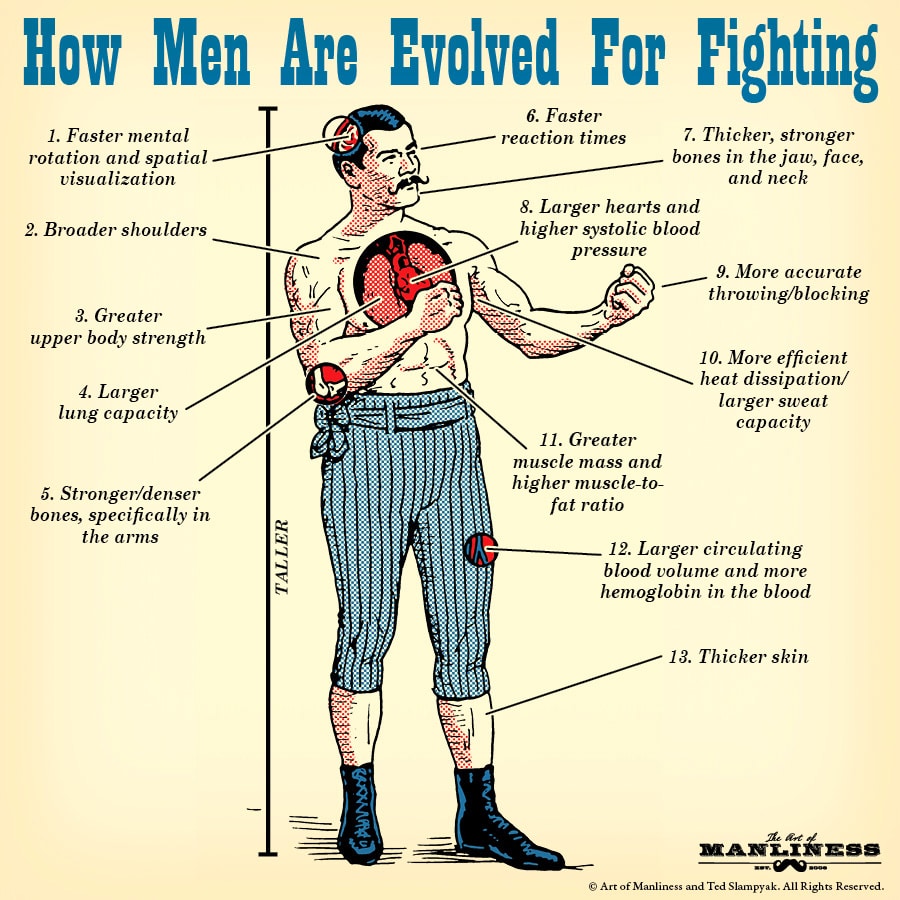Men seem to be drawn to combative athletics and physical jobs. Violent sports like mixed martial arts remain male dominated, and 85.5% of active duty military members are men.
Statistics also show that men are more likely to commit violent crimes than women. These violent crimes range from assault and battery in a barroom fight to straight-up homicide.
Why is it that men are more prone to violence, whether recreationally, vocationally, or criminally? Many academics would argue that it’s solely a matter of social conditioning — that men are violent and aggressive because society teaches them to be violent and aggressive.
But other researchers from the fields of evolutionary biology and anthropology suggest that while social conditioning may have some influence on male behavior, men are in many ways biologically and psychologically wired to fight.
In a 2012 paper entitled “The Importance of Physical Strength to Human Males,“ a group of academics from the fields of anthropology and evolutionary psychology compiled research from several domains that suggest that evolutionary and reproductive pressures in our distant past nudged males in our species to develop a propensity for risk taking and violence, as well as physical traits that would be valuable in violent confrontations. The features researchers think are the result of selection for fighting are those which testosterone turns on and grows — e.g., think of the way the surging testosterone in an adolescent male during puberty increases the size of his musculature and capacity for upper body strength.
Because the competition for resources and reproductive success was much more intense among males than females, being bigger, stronger, and more adept at fighting provided a big advantage for men.
Basically, the argument is that much of what makes men different than women can be chalked up to males’ need to fight other males.
The fields of evolutionary psychology and biology are often very speculative, and it’s impossible to say that X traits definitely developed for X reason. For example, there are researchers who say that the structure of the human hand developed to allow us to make a fist and punch each other better, while others say its structure evolved to allow us to make and use tools. The intersection of biology, psychology, and sociology is quite complex, and boiling down who we are to a simple matter of evolution would be short-sighted and reductionist.
Those caveats aside, the speculation is certainly fascinating to entertain! Just because you’re wired to fight, doesn’t mean you’ve got to become a full-time fisticuffer, but you might look for ways to scratch that primal itch. Plus it’s just cool to look in the mirror at your naked body in the morning, and realize that your unique features were designed for combat. You’ve got warrior DNA. It’s certainly good motivation to get to the gym and not let traits thousands of years in the making go to waste. Honor your ancestors!
Next time you’re giving yourself a look over, contemplate these features that may have been made for combat:
1. Faster mental rotation and spatial visualization. Could come in handy in a fast-changing dynamic like a fight. Researchers have made connections between play fighting and spatial visualization. Recent research has shown that women can close the gap with training, but it appears men have an inherent predisposition to this trait.
2. Broader shoulders. Allows for more forceful punching and throwing. Broader shoulders also served as a deterrent to would-be aggressors. They signaled “Don’t mess with me, I can pummel you.” Because of their signaling ability, anthropologist Richard Wrangham has said that broad shoulders “are the human equivalent of antlers.”
3. Greater upper body strength. Useful in punching, grappling, and throwing weapons (rocks, spears, etc.).
4. Larger lung capacity. Useful in high-intensity, cardiovascularly-taxing activities like fighting.
5. Stronger/denser bones, specifically in the arms. Useful in inflicting more damage on an opponent. Stronger bones mean you’re less likely to experience fractures during hard physical challenges. Greater bone strength is due to increased testosterone levels in men.
6. Faster reaction times. Quicker reflexes. Useful in avoiding punches, projectiles, and other aggressive attacks.
7. Thicker, stronger bones in the jaw, face, and neck. Stronger, thicker facial and jaw muscles and bones allow for better absorption of the energy of a punch, lessening the possibility of a broken jaw or concussion.
8. Larger hearts and higher systolic blood pressure. A larger heart and a bit higher systolic blood pressure can better pump blood to muscles during a strenuous activity like a fight. Of course, having too large a heart and too high blood pressure can be dangerous to cardiatric health.
9. More accurate throwing and blocking. Useful in throwing rocks, spears, fists, etc. in a fight as well as avoiding incoming rocks, spears, fists, etc.
10. More efficient heat dissipation/larger sweat capacity. Increases endurance during physical activity, particularly if that activity takes place in dry and extremely hot weather. While women have overall higher heat dissipation due to their decreased body mass, men’s heat dissipation is more efficient when you take into account their overall larger size.
11. Greater muscle mass and higher muscle-to-fat ratio. More muscle = more strength. Strength is certainly something you want in hand-to-hand combat.
12. Larger circulating blood volume and more hemoglobin in the blood. Increased oxygen efficiency that could come in handy while battling another. Men also have higher circulating clotting factors compared to women which leads to faster wound healing.
13. Thicker skin. Possibly aides in the prevention of wounds that may occur during physical combat.
14. Taller. Enables you to punch with more force. Punching downward rather than upwards allows you to punch with 200% more force. Taller men thus have an advantage in a fight.
Like this illustrated guide? Then you’re going to love our book The Illustrated Art of Manliness! Pick up a copy on Amazon.



